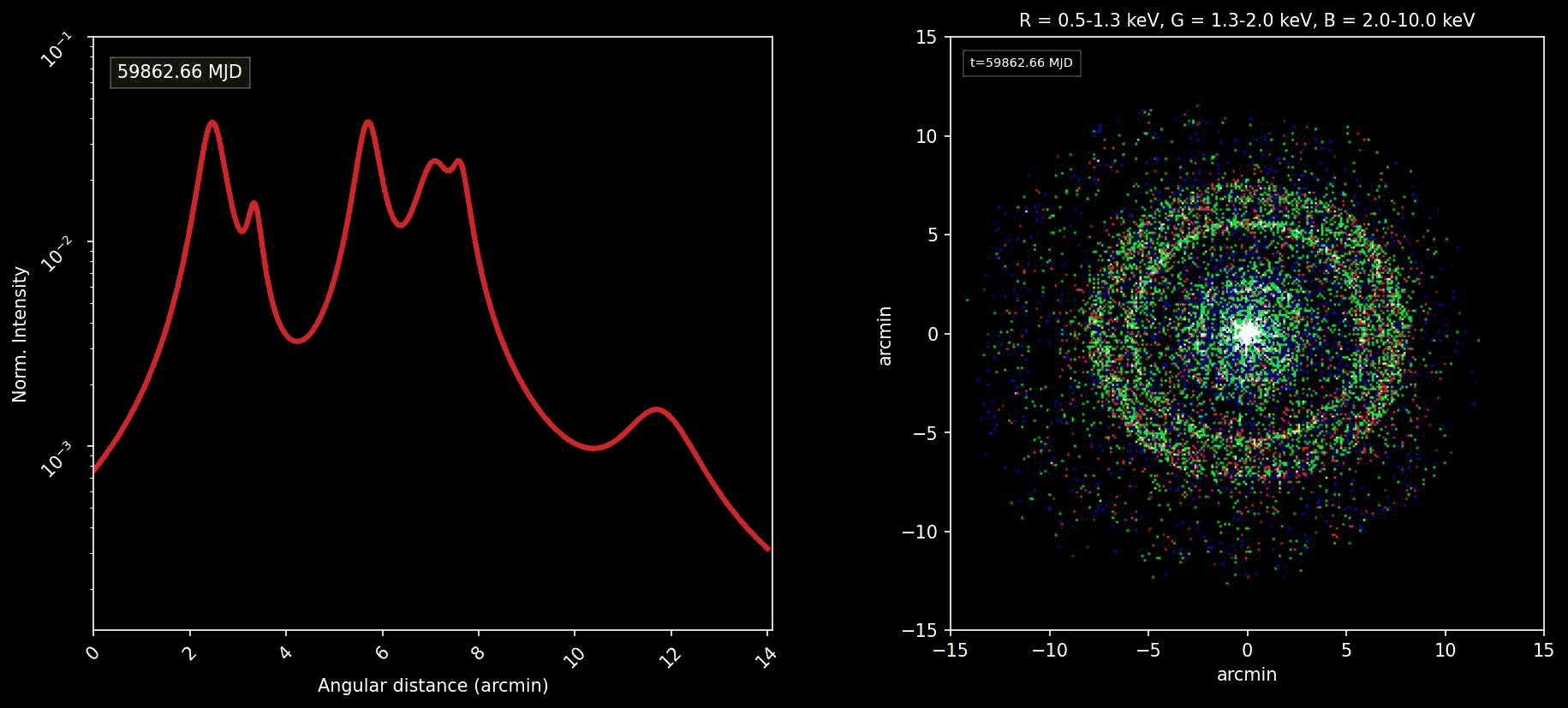An article written by Maria Petropoulou, Assistant Professor, Department of Physics

Cosmic dust is made of various elements, such as carbon, oxygen, and silicate compounds. It is a key element of the stellar cycle of life: stars produce dust as they age or when they explode as supernovae, enriching space with elements heavier than hydrogen and helium, spawning new generations of stars and orbiting planets.
Dust particles are typically small, measuring between a few molecules in size up to a few micrometers. Dust interacts with light (electromagnetic radiation) in different ways, such as absorption and scattering, depending on the wavelength of incoming radiation and properties of dust particles (size, shape, index of refraction). While optical light is blocked by dust, X-rays with energies greater than 1 keV (or wavelength less than 1 μm) are preferentially scattered by dust grains with size about 0.1 μm. As a result, the incoming X-rays change direction as illustrated in the cover image, and are detected with some time delay with respect to X-ray photons arriving directly from the source without scattering.

When large concentrations of dust intersect our line of sight to an X-ray transient, what we observe on the plane of the sky is an X-ray ring centered at the position of the source (right panel, Fig.1). The angular size of the ring depends on the distance of the dust screen, with the more distant layers producing smaller rings. By identifying peaks in the X-ray angular profile (left panel, Fig.1) we can infer the number of dust layers intersecting our line of sight. Using the derived peak positions we can then model the ring expansion with time, and derive the time of the X-ray burst and the distances of the dust layers. Finally, by measuring the relative ratio of the X-ray fluxes of rings, we can estimate the relative ratio of the dust content, since the brightness of a ring is proportional to the amount of cosmic dust in the layer.
On October 9, 2022 the Neils Gehrels Swift Observatory detected GRB 221009A, an unusually bright gamma-ray burst (GRB) at a distance of 2.4 billion light years. Due to its high luminosity and proximity to Earth, GRB 221009A was coined the GRB of the century. Observations performed with the X-ray Telescope (XRT) on board Swift up to 3.5 days post-discovery revealed the presence of multiple rings around the source (Fig.1).
G. Vasilopoulos, post-doctoral researcher at CNRS/Strasbourg, in collaboration with D. Karavola (MSc candidate in Astrophysics, NKUA), S. I. Stathopoulos (PhD candidate in Physics, NKUA), and myself analyzed publicly available XRT data to study the Galactic dust in the direction of this rare GRB. We found a total of 15 dust layers that span in depth about 25 kpc[1] — this is the largest distance range probed by X-ray scattering rings so far. By comparing the relative scattered fluxes of the five most prominent rings we showed that the layer with the largest amount of dust is located at about 1.1 kpc away from us. The observations are consistent with scattering by dust grains with a maximum size of 0.3 μm and a power-law distribution extending to smaller sizes. In conclusion, our results highlight the power of X-ray tomography in mapping the dust content of our Galaxy.
Vasilopoulos G., Karavola D., Stathopoulos S. I., Petropoulou M., “Dust-scattering rings of GRB 221009A as seen by the Neil Gehrels Swift satellite: can we count them all?”, 2023, MNRAS
Open access article: http://arxiv.org/abs/2302.02383
[1] 1 kpc is 3261.56 light years. The diameter of the Milky Way is about 26 kpc.








 The session has ended for security reasons.
The session has ended for security reasons.